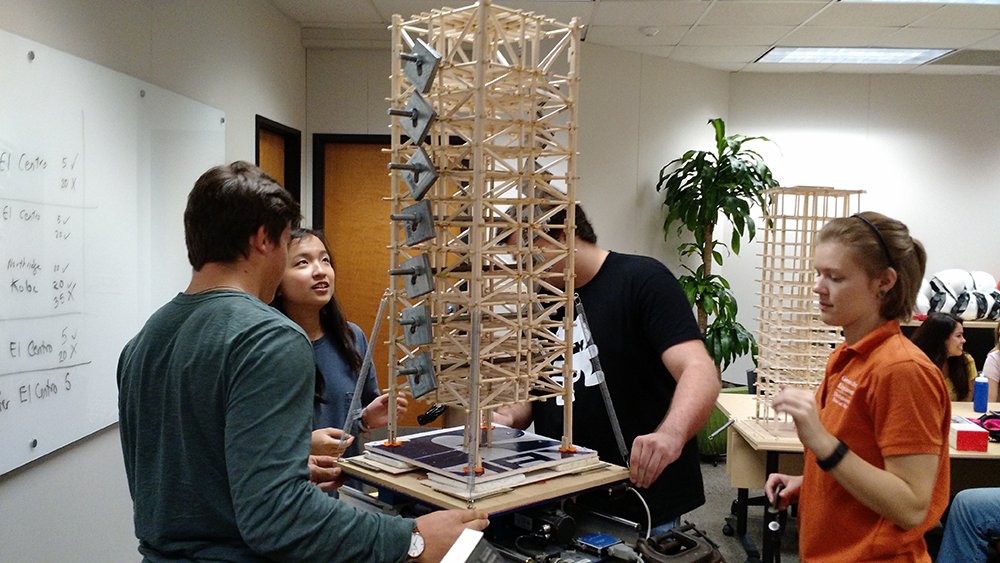Shake Table Competition Introduces Students to Natural Hazards Engineering
DesignSafe initiative hosts students and works to develop curriculum
Published on May 18, 2016
Makeda Easter, Texas Advanced Computing Center

In a single year, earthquakes can cause thousands of deaths and affect millions of people around the world, but sometimes it can be hard to understand the devastation from afar. However, this spring 31 students from St. Stephens Episcopal School in Austin, Texas, got an up-close look at the importance of engineering through an earthquake simulation activity.
After completing an earthquake unit in their engineering class, the nine juniors and 22 seniors constructed balsa wood towers and brought them to the Ferguson Structural Engineering Lab (FSEL) at The University of Texas (UT) for a structural design challenge. After touring the large-scale structural testing facilities of FSEL, the high school students visited the NHERI@UTexas facility next door, which houses large, one-of-a-kind shaker trucks that are used to study the seismic performance of soils, foundations, and structures world-wide.
The NHERI@UTexas facility is part of the Natural Hazards Engineering Research Infrastructure (NHERI), which includes a collection of seven experimental facilities that provide the natural hazards research community with access to unique testing capabilities. Funded by NSF, NHERI also includes the DesignSafe Cyberinfrastructure, a cloud-based environment for data sharing and high performance computing to support research in natural hazards engineering.
As part of the DesignSafe plans for education and outreach, the activity has contributed to the development of curriculum in natural hazards. We want to inspire students to study natural hazards engineering by showing them that this field of study integrates high-tech computation and experimentation to ultimately save lives, said Ellen Rathje a civil engineering professor at UT and principal investigator of the project.
The day of the competition was filled with the sound of crashing wood and laughter. Led by Patricia Clayton, assistant professor in the UT Department of Civil, Architectural, and Environmental Engineering, students tested the strength of their models using an educational shake table.
Shake tables are tools that can replicate seismic ground motions collected from historic earthquakes. After adding weights to the models to mirror the mass of actual buildings, the models were subjected to three earthquakes, each increasing in intensity the 1994 Northridge, California earthquake, the 1940 El Centro, California earthquake, and the 1995 Great Hanshin, Japan earthquake.
Several models survived the first three tests and were then subjected to an adjustable sine wave, which shook the models with increasing intensity until they reached their final breaking point.
Students got a sense for how engineering for natural hazards, such as earthquakes, can really impact people. When you see a model that totally collapses, you think wow, that could be a real building that collapses during an earthquake and kills many people, Clayton said.
Participants in the program agreed. This experience helped me better understand the impact that natural disasters can cause, said Jennifer Jou, a junior and aspiring mechanical engineer. I also realized the safe houses and apartments we now live in are based on the efforts of the civil engineers around the world.
The competition also provided the opportunity for the Texas Advanced Computing Centers Education and Outreach group to test their new accelerometer design. The Wi-Fi streaming device, which was placed on top of several models, collected data for students to analyze after the shake tests.
The low-cost accelerometer is constructed from consumer grade components with open source design, firmware, and software for students of all levels to modify, explore and apply to new contexts and experiments. The software and design are publicly available on github. This design will be useful for future education and outreach programs.
With the accelerometer, students are using the same data collection and sharing techniques that engineers use on DesignSafe, said Joon-Yee Chuah, program coordinator on TACCs education and outreach team. The ultimate goal for DesignSafe is to take sensored data, stream it into database, and share it with the scientific community using the portal.
After the competition, students spent the rest of the day learning about new technologies and earthquake research happening at FSEL and NHERI@UTexas.
By looking at research thats going on in a laboratory or the seeing the shaker trucks and hearing a little bit more about how those are used to better understand earthquakes and soil properties, students can see that there are new things left to learn, Clayton said. Thats a benefit of coming to UT and seeing research facilities in person you cant get that in the classroom.







